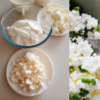Simple recipe for homemade cottage cheese
Because of its smooth texture and mild flavor, cottage cheese has long been a staple in kitchens all around the world. Even if store-bought alternatives are widely accessible, preparing your own cottage cheese at home has a very fulfilling quality.In this exhaustive instructional exercise, we’ll dive into the craft of making custom-made curds, the subtleties of picking fixings, the difficult souring process, and the delight of tasting the eventual outcome.Follow us on this gastronomic excursion as we share the techniques for making a clump of velvety, heavenly curds that will hoist your culinary abilities.

Cottage Cheese
Equipment
- Large stainless steel or enamel pot
- Thermometer
- Long knife
- Colander
- Bowl for draining whey
Ingredients
- 1 gallon whole milk
- ¼ cup white vinegar or lemon juice
- 1 teaspoon salt (adjust to taste)optional,
Section 1: Basics of Cottage Cheese Making
1.1 Selection of suitable components:
To begin our cottage cheese-making venture, we must start with quality ingredients.
Matters of Milk:
- Start with a gallon of whole milk. Choose high-quality, preferably organic or locally sourced milk, for the best taste and texture. To get the creamy consistency associated with cottage cheese, whole milk must be rich.
Choosing a Curdling Agent:
- An essential component in the process of manufacturing cheese is a curdling agent. White vinegar or freshly squeezed lemon juice acts as a catalyst that begins the separation of curds and whey. The choice between the two depends on personal preference and the taste you are aiming to achieve.
1.2 Equipment required:
Collect the necessary tools to ensure the cottage cheese-making process.
The Pot:
- Choose a large stainless steel or enamel pot.This substance is ideally suited for scattering intensity and turning away unfortunate associations with milk.
Thermometer:
- Precision is the key to making cheese. All through the strategy, a dependable thermometer will be helpful for temperature checking.
Cutting Tools:
- A long knife is required to cut the curd into uniform pieces after processing. It is a simple yet crucial tool to achieve the desired texture.
Cheesecloth:
- This fine mesh fabric will help separate the curds from the whey during the draining stage.
Colander and bowl:
- Straining the whey requires a colander lined with cheesecloth, with a bowl placed underneath to collect the liquid.

Section 2: Step-by-step process
2.1 Heating milk:
- The first step in our journey to making cottage cheese involves heating the milk.
- Begin by pouring a gallon of whole milk into a large pot.After setting the saucepan over medium heat, gradually bring the milk’s temperature up to 190°F (88°C). Mix the milk at times to keep it from being consumed.
- A mild heat treatment is crucial to denature the proteins in the milk, which is a key preliminary step to the curdling stage.
2.2 Addition of curdling agent:
- Take the milk off the heat source as soon as it reaches the desired temperature. The next step is to introduce a curdling agent—either 1/4 cup white vinegar or lemon juice.
- Add the selected acid to the milk, stirring gently to distribute it evenly. Let the mixture sit undisturbed for about 5 minutes to allow the acid to interact with the milk proteins.
2.3 Curing and cutting:
- After the waiting period, check for curd formation. The whey, or liquid component, should appear clear, indicating successful separation of the curd.
- Using a long knife, carefully cut the curd into small, even pieces, about 1/2 inch in size. For consistency, make both horizontal and vertical cuts.
2.4 Cooking Curd:
- Return the pot to the oven at low intensity. Slowly heat the yogurt to 105°F (40°C), stirring gently to prevent curdling. This stage is key to taking out the whey and affecting the curds’ conclusive surface.
2.5 Whey Removal:
- Now that the curd is formed and cooked, it’s time to separate it from the liquid buttermilk.
- The remaining whey should not be discarded. It will in general be used in other culinary endeavors, adding a healthy lift to soups, stews, or warmed items.
- Line a colander with cheesecloth and spot it over an enormous bowl or sink. Carefully pour the curds and whey through the cheesecloth, so that the whey drains away, leaving behind the precious curds.
2.6 Rinsing and salting:
- Rinse the curd under cold, running water to remove any residual whey. This not only cleans the curd but also helps cool it.
- At this point, you have the option of adding salt for extra flavor. Sprinkle salt over the curd and mix in gently, adjusting the amount to suit your taste preferences.
2.7 Hanging and Draining:
- To achieve the desired consistency, tie the corners of the cheesecloth together, forming a pouch containing the curd. Suspend the pouch to drain for about 1–2 hours.
- The duration of the draining process influences the final composition. A longer draining time gives a drier cottage cheese, while a shorter time results in a creamier consistency.
2.8 Collection and enjoyment:
- Once the draining process is complete, transfer your homemade cottage cheese to a container and refrigerate.Presently, your creation is fit to be appreciated in different dishes or delighted in all alone.

Section 3: Tips and Variations
3.1 Utilization of leftover whey:
- Whey, a byproduct of the cheese-making process, is a valuable ingredient in its own right.Rather than disposing of it, consider integrating it into your culinary collection.
Buttermilk in cooking:
- As a foundation for soups, stews, or sauces, use buttermilk. Its high protein content raises the perceived value of various foods.
Baking with buttermilk:
- Include buttermilk in your baking efforts. Use it as a liquid ingredient in bread recipes or as a milk substitute in some baked goods.
3.2 Taste experiment:
- Cottage cheese serves as a versatile canvas for flavor experiments. Enhance your composition by infusing it with herbs, spices, or even fruit during the draining process.
Herb-infused cottage cheese:
- Insert fresh herbs such as rosemary, thyme, or dill before hanging to drain curds. The outcome is a curd with brilliant natural connotations.
Sweet Variation:
- For a sweet twist, consider topping yogurt with honey, cinnamon, or vanilla.This variant increases the versatility of your own cottage cheese by working well in both savory and sweet recipes.
Title: Unveiling the Art of Homemade Cottage Cheese: A Comprehensive GuideQuaker Rice Cakes racipeQuaker Rice Cakes racipeQuaker Rice Cakes racipe
Introduction:
Cottage cheese, with its velvety texture and delicate flavor, has long been a staple in households around the world. While store-bought options are readily available, there’s something deeply satisfying about crafting your own cottage cheese at home. In this comprehensive guide, we’ll delve into the art of making homemade cottage cheese, exploring the nuances of selecting ingredients, the meticulous curdling process, and the joy of savoring the final product. Join us on this culinary journey as we unravel the secrets to creating a batch of creamy, flavorful cottage cheese that will elevate your kitchen prowess.
Section 1: The Basics of Cottage Cheese-Making
1.1 Selecting the Right Ingredients:
To embark on our cottage cheese-making adventure, we must start with quality ingredients.
Milk Matters:
Begin with a gallon of whole milk. Opt for high-quality, preferably organic, or locally sourced milk for the best flavor and texture. The richness of whole milk is essential to achieving the creamy consistency associated with cottage cheese.
Choosing the Curdling Agent:
The curdling agent is a critical component in the cheese-making process. White vinegar or freshly squeezed lemon juice serves as the catalyst that initiates the separation of curds and whey. The choice between these two depends on personal preference and the flavor profile you aim to achieve.
1.2 Essential Equipment:
Gather the necessary tools to ensure a smooth cottage cheese-making process.
The Pot:
Select a large stainless steel or enamel pot. These materials are ideal for even heat distribution and preventing undesirable reactions with the milk.
Thermometer:
Precision is key in cheese-making. A reliable thermometer will help monitor the temperature throughout the process.
Cutting Tools:
A long knife is essential for cutting the curds into uniform pieces later in the process. It’s a simple yet crucial tool for achieving the desired texture.
Cheesecloth:
This fine mesh fabric will aid in separating the curds from the whey during the draining stage.
Colander and Bowl:
A colander lined with cheesecloth is essential for draining the whey, with a bowl placed beneath to collect the liquid.
Section 2: The Step-by-Step Process
2.1 Warming the Milk:
The first step in our cottage cheese-making journey involves warming the milk.
Begin by pouring the gallon of whole milk into the large pot. Place the pot on the stove over medium heat and gradually warm the milk to around 190°F (88°C). Stir the milk occasionally to prevent scorching.
The gentle heating process is crucial for denaturing the proteins in the milk, a key preparatory step for the curdling stage.
2.2 Adding the Curdling Agent:
Once the milk reaches the desired temperature, remove it from the heat. The next step is to introduce the curdling agent – either 1/4 cup of white vinegar or lemon juice.
Add the chosen acid to the milk, stirring gently to distribute it evenly. Allow the mixture to sit undisturbed for approximately 5 minutes, allowing the acid to interact with the milk proteins.
2.3 Curd Formation and Cutting:
After the waiting period, check for the formation of curds. The whey, or liquid component, should appear clear, indicating a successful separation of curds.
Using a long knife, carefully cut the curds into small, uniform pieces, approximately 1/2 inch in size. Employ both horizontal and vertical cuts to ensure consistency.
2.4 Cooking the Curds:
Return the pot to the stove over low heat. Gradually warm the curds to 105°F (40°C), stirring gently to prevent matting. This step is crucial for expelling whey and contributing to the final texture of the cottage cheese.
2.5 Draining the Whey:
With the curds now formed and cooked, it’s time to separate them from the liquid whey.
Line a colander with cheesecloth and place it over a large bowl or in the sink. Carefully pour the curds and whey through the cheesecloth, allowing the whey to drain away, leaving behind the precious curds.
The leftover whey should not be discarded; it can be utilized in other culinary endeavors, adding a nutritional boost to soups, stews, or baked goods.
2.6 Rinsing and Salting:
Rinse the curds under cold running water to remove any residual whey. This not only cleans the curds but also aids in cooling them down.
At this point, you have the option to introduce salt for added flavor. Sprinkle salt over the curds and gently mix it in, adjusting the amount to suit your taste preferences.
2.7 Hanging and Draining:
To achieve the desired consistency, tie the corners of the cheesecloth together, creating a pouch containing the curds. Suspend the pouch to drain for approximately 1-2 hours.
The duration of draining influences the final texture; a longer draining time yields drier cottage cheese, while a shorter duration results in a creamier consistency.
2.8 Storing and Enjoying:
With the draining process complete, transfer your homemade cottage cheese to a container and refrigerate. Now, your creation is ready to be savored in various recipes or enjoyed on its own.
Section 3: Tips and Variations
3.1 Utilizing Leftover Whey:
The whey, a byproduct of the cheese-making process, is a valuable ingredient in its own right. Instead of discarding it, consider incorporating it into your culinary repertoire.
Whey in Cooking:
Utilize whey as a base for soups, stews, or sauces. Its rich protein content adds nutritional value to a variety of dishes.
Baking with Whey:
Incorporate whey into your baking endeavors. Use it as a liquid component in bread recipes or as a substitute for milk in certain baked goods.
3.2 Flavor Experimentation:
Cottage cheese serves as a versatile canvas for flavor experimentation. Elevate your creation by infusing it with herbs, spices, or even fruits during the draining process.
Herb-Infused Cottage Cheese:
Introduce fresh herbs like rosemary, thyme, or dill to the curds before hanging them to drain. The result is a cottage cheese with a delightful herbal undertone.
Sweet Variations:
For a sweet twist, consider infusing the curds with honey, cinnamon, or vanilla. These variations can be used in both sweet and savory dishes, expanding the possibilities of your homemade cottage cheese.
Conclusion
In summary, figuring out how to make cottage cheese at home is a great and exploratory cycle. Making your own curds gives a sensation of culinary accomplishment, from the purposeful stages engaged with coagulating and depleting to the insightful fixing choice.
You will actually want to deliver lovely, rich bunches of curds by following this careful instructional exercise, which likewise opens you a universe of innovative potential outcomes and variations. A testament to the delights of artisanal cuisine, your homemade cottage cheese can be eaten on its own, added to recipes, or shared with loved ones. Put on your apron, get your ingredients ready, and then let your kitchen fill with the aroma of freshly made cottage cheese, turning it into a gastronomic paradise.









[…] Wholesome Snacking: 3 rich Cottage Cheese Snack Ideas […]